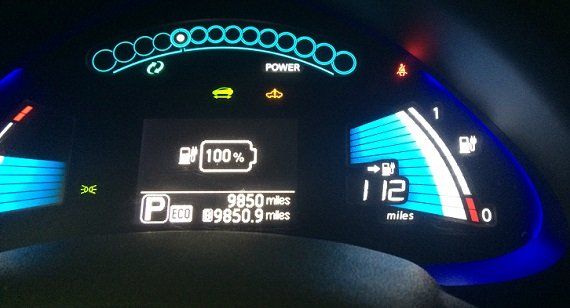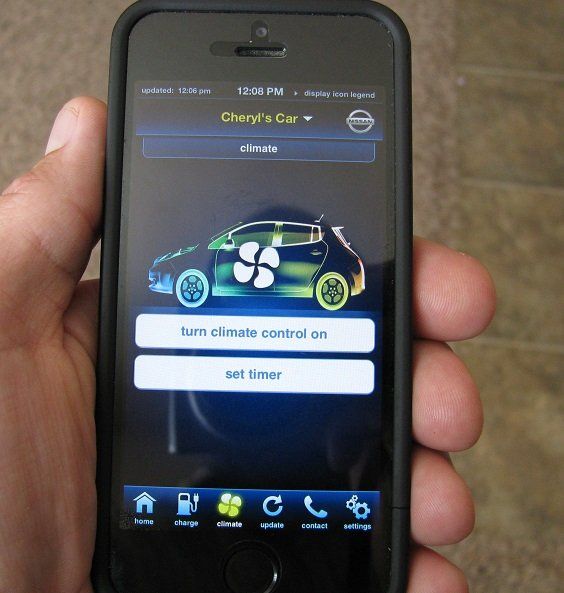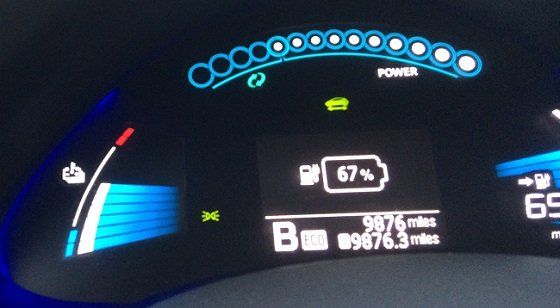Published Saturday August 2, 2014: Updated April 17, 2016
How to Consistently get 100+ Miles of Range in a Nissan Leaf
(125+ miles with 30 kWh battery pack).
(125+ miles with 30 kWh battery pack).
A while back, I read a detractor’s opinion article
about the Nissan Leaf. In it he wrote how the actual range is only 27-38 miles. It made laughably unrealistic assumptions, fearfully pessimistic projections about the battery life and had no merit whatsoever in relation to real-world driving. But it hinted on one good point, that driving style and driving conditions will impact the total driving range of the car.
If a pessimist can attain poor driving range, why can't an optimist regularly achieve outstanding range?
The average advertised range of the Nissan Leaf is 84 miles. While it is not every day that we find ourselves needing to go that far, I have on many occasions exceed 100 miles of freeway range on a single charge in the Leaf. This is verified by actually driving more than 100 miles on a single charge. My wife who is also mastering the range extending driving techniques, has me beat with 112 miles on a single charge, (much of that was driving on the freeway). She does this nearly every time she goes to Ikea in Draper, UT too. It's a 90+ mile round-trip, almost all freeway.
Here is a collection of vehicle settings and driving techniques so you too can achieve over 100 miles of consistent driving range, (even on the freeway), in your Nissan Leaf.
Vehicle Settings: The low-lying fruit
Charge Battery to 100%:
This is an obvious one but often times, people often only charge their Leaf up to 80% in hopes that this will extend the life of the battery.
Nissan used to recommend doing this too but they don't anymore. I wonder if they have since gathered enough data about battery life and concluded that it isn't necessary to limit the range on purpose? Or maybe it's the new battery chemistry they use now? I don't know and I have yet to find more data on the topic, other than you should not let the car sit for an extended period of time (weeks or months) with a 100% full battery. In any case, set the battery to charge up to 100%.
The Economy Switch: The Nissan Leaf has an economy button on the steering wheel that changes the sensitivity of the throttle pedal. I don’t know why this should matter. Burying the throttle pedal will still push you back in your seat. By keeping it in Economy mode, you still have a very peppy Leaf but your range is extended by 7-10 miles.
B-Mode
vs. D-mode: Why throw away precious kinetic energy? Reclaim as much as you can. Starting in 2013, The Nissan Leaf added 2 driving modes. "D" for regular driving mode and "B" for braking driving mode. While both modes offer some regenerative braking functionality, B-mode is much more aggressive and effective at recovering excess kinetic energy when you need to slow down anyway. Whenever you let off the throttle, the car instantly begins to slow down. This allows you to come nearly to a complete stop without having to use the regular friction brakes at all. In the city, this will increase range dramatically. Even driving on the freeway, using B-Mode will re-capture more energy than D-mode could (like when traffic is slowing or when you are exiting the freeway).
Personally, I prefer B-mode all the time and wish it was always engaged by default. As a comparison, aggressiveness of B-mode on the Leaf feels very similar to the regenerative brake in a Tesla Roadster and Model S.
Follow Battery Percentage and Not Miles Remaining: The mileage guess-o-meter is based off of past performance. If you just drove down a long canyon or just completed a lot of slower, city driving, the range indicator will give you a false high range estimate. You may think you have lots of miles until you get on the freeway and the miles remaining quickly drop off.

If the battery percentage number is the same as the range remaining number, that is a good predictive indicator that you have 100 miles of range in the Leaf on a full charge.

In the above picture, we had just finished driving 64 miles (most of it on I-15) from Kaysville to Holladay Utah and back again (going there, A/C was on, coming back it was off). The remaining mileage estimate is higher than battery percentage. This means the range (based on past driving) is more than 100 miles.

After 2.5 hours on the Juicebox charging station at home, the battery was full and the range showed an estimated 112 miles.
Higher Tire Pressure:
Fill the tires to higher pressure (up to, but not exceeding the max-side wall pressure). At the cost of a slightly bumpier ride, you Leaf will go 8-12 miles further on a charge. Personally I fill my tires to the max-sidewall pressure (44 psi). Using the Leaf Spy app, you can monitor the tire pressure while in motion. The tire pressure in my car goes up to around 46-47 psi after driving 20 miles but I don't lose sleep over it.
Drive When It’s Warmer Outside:
Fuel economy in Northern Utah will ALWAYS be worse in the winter time than during the summer time. This is because when it’s cold outside, air density is higher, (the air is thicker).

In the winter time, if you have the option of doing your driving when the sun is up and it's warmer outside, do it. Although if there is more stop/go traffic, it may negate the efficiency gains of lower air density. In cold climates, cabin heater demands will also be lower when the sun is up.
In hot climates, energy savings from reduced air drag, (from low air density caused by higher air temperatures), may be negated by the need for additional cabin climate controls. In that case, driving early in the morning hours will save more energy and extend range.
The theoretical, ideal place for an electric car would be at a high elevation location where the air is thin and outside air temperatures are always at room temperature, (when climate controls are unnecessary).
Gas cars don't perform well at high elevation but Electric cars could care less, which is why NASA chose to use electric cars 250,000 miles above the Earth, on the MOON. Every vehicle that roams the Martian surface is also an EV.
Keep Your Car Out of the Elements by Parking Inside:
A double whammy to cold air temperatures, is the Nissan Leaf’s battery doesn’t perform as well when its cells are super cold (like after sitting unused, all weekend, in sub-zero temperatures).
Do what you can to park in an insulated garage where the temperature extremes are reduced. At home, we chose to insulate our attached garage for this very reason. Now, even when it is well below freezing outside, it rarely drops below 40° F in the garage, during the winter time.
Pre-heat the Car's Cabin while Plugged in to House Power:
The coolest feature of the Nissan Leaf SL and SV has got to be the CarWings app, where you can remotely control the climate of the cabin while you are away.

But even the base model Leaf has a timer that you can set. On those frigid mornings, your car's cabin can be smokin' hot, the moment you get in.
Or in the summer time, the cab could be nice and cool, even after the car has been broiling in the hot sun all day.
If you can do either while the car is still plugged in, the cabin temperature will already be set and you will have more battery energy for driving farther, since less will be spent on climate controls during driving.
Driving Techniques: Adjusting the "NUT" behind the wheel
Drive Slower:
Air drag increases by the cube of your speed. Indy 500 cars need 700 hp engines for one reason only. To overcome air friction.

Let’s face it. You aren't going to go on a super long road-trip in a Nissan Leaf. That’s not the application for which it was designed. Save that trip for a gas car, or if you can afford it, (I wish), get a Tesla Model-S or Model-X and carry up to seven people, (and all their stuff), on that cross country road-trip.
Since you won’t be driving much farther than 100 miles at a time in the Leaf, driving faster will not shave a significant amount of time from your commute. At the expense of 2-6 extra minutes driving the distance of an average commute, drive 63 mph on the freeway instead of 75 or 80 mph. Just don’t be a jerk. Please get into the right-hand lane if you happen to be going to go slower than everyone else.
Let all the road raged, rat racers, with severe diarrhea have the fast lanes. Let them get the speeding tickets, anxiety, high blood pressure and stress. In return, you will be driving happy, with an additional 15-30% extension in driving range.
Accelerate Slower:
Drive so fewer bubbles light up white on the Leaf's dash board.

Not like this: Full throttle with 80kW of energy going to the motor.
If you can spare a few extra seconds getting up to speed, do it. A slower acceleration will save energy over a faster one.
Yes, per the laws of Physics, the Leaf’s 80kW electric motor, with its instant torque will completely annihilate most gas cars and trucks off the line, (even ones with much larger engines). While it is immensely fun to do, (leaving everyone else in the dust at every green light or freeway on-ramp), is not conducive to maintaining 100 miles of battery range.
Besides, that guy in the next lane over, driving the enormous diesel truck, with the over-sized tires and twin smoke stacks, attempting to enshroud your environmentally responsible Leaf in a cloud of Earth-hating, black smoke, has enough “size” and "compensation" issues to deal with. Losing a simple, off-the-line race to an un-suspecting soccer mom in a totally silent, electric hatchback, just might send him over the edge.

Example of a driver who might get their pride hurt, racing a Nissan Leaf.
Anticipate stops:
The less you have to use your brakes, (even regenerative brakes), the more energy you conserve. If you know that the light up ahead will turn red by the time you get there, coast to it. By the time you get there, it could be green and you can keep on rolling through it.
It's enjoyable coasting up to an anticipated red light as other cars race past me. Then, after they have all screeched to a stop, the light turns green and I leisurely roll past them as they compete against themselves in a panic to get going again. Ahhh, the simple pleasures.
Drive When the Freeway Traffic is Moderately Full but Still Flowing Quickly:
This one may be out of your control but driving with lots of cars, all going roughly the same speed, causes the air along the freeway lanes to move in the same direction as the traffic. In relation to air friction, this effectively reduces your air-drag and energy use. I-15 through Davis County (high sound walls and wind trapping terrain) is a good example that regularly experiences this phenomenon.
Since air friction is such a huge player in vehicle fuel efficiency, this can have dramatic effects. Battery current draw is 20-30% less in this situation as opposed to going the same speed on an empty freeway. It's the equivalent to reducing your speed by an additional 8-12 mph.
While the I-15 corridor through Davis county has this energy saving air flow effect, I actually drive to work on Legacy Highway which has less traffic, no sound wall, wide open expanses and cross-winds.
To my destination, it is shorter by 1 mile, is a lot more scenic and pleasant on which to drive. Going 55 mph on Legacy Highway vs going 65 mph with air friction perks on I-15 is almost a wash, as far as energy use is concerned.
Remove the mud flaps:
If your Nissan Leaf has the mud-flaps option, take them off. Mud flaps are fine if you mostly drive on wet, muddy roads but they also act like sails and cause unnecessary air drag.
Flip your Mud-Flaps into Tire Spats:
I have yet to try this one but some have actually flipped the mud flaps around and installed them on the front side of the wheel well, effectively transforming the mud flaps into tire spats and gaining a few miles of range increase while traveling at highway speeds.
Update 5/31/2015:
Since January 2015, I have been commuting to work in a 2012 Nissan Leaf. I'm finding that no matter how efficiently I drive, it will not go as far as the 2013 model year. I dare say that you would be hard pressed to actually go 100 miles (real world highway/city driving), on a single charge, in a 2012 Leaf.
Update 4/17/2016:
The 2016 SL and SV models of the Nissan Leaf now come with a larger 30kWh battery pack and an EPA rated range of 106 miles. While I have yet to take one of these cars through its paces, by following the driving techniques listed above, the range of one of these electric cars could potentially exceed 125 freeway miles.
